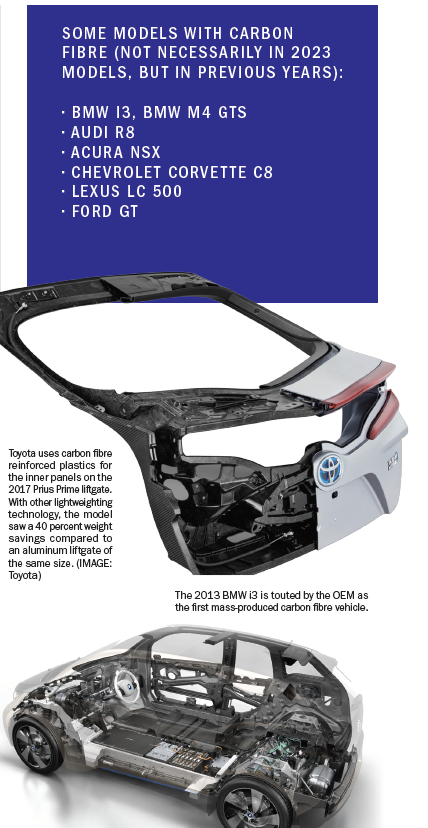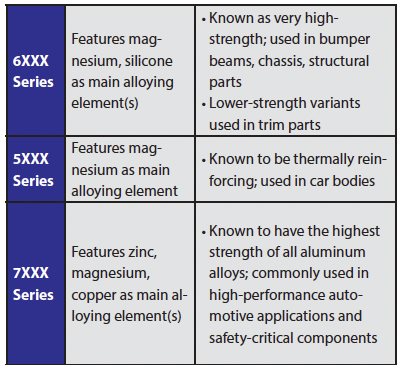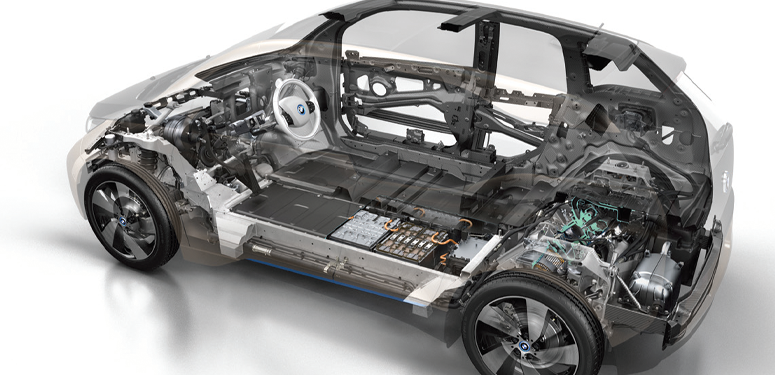WHAT MAKES A CAR?
EIGHT EMERGING MATERIALS YOU COULD SEE IN EVS
By Allison Rogers
Remember, back in 2015, when Ford swapped the F-150 to an aluminum body? It shook up the industry.
Now, imagine that on a way, way larger scale. That’s what we’re in for.
Electric vehicles, along with efforts in sustainability, vehicle longevity and always-advancing technologies, will bring a world of change to unprepared collision repairers.
We’ve outlined some of the new materials popping up on the automotive scene—here are eight emerging materials that could soon be rolling into a bay near you.
CARBON FIBRE REINFORCED POLYMERS
Also known as CFRP, carbon fibre-based materials are favoured in automotive applications due to their impressive strength-to-weight ratio. They are often used in body panels such as hoods, roofs, fenders, and trunk lids, helping to reduce the overall weight of a vehicle. CFRP was first used in limited applications in the 1980s and 1990s, primarily in high-performance sports cars and race cars. Its use became more widespread in the 2000s with advancements in manufacturing processes and materials technology, making it more affordable and practical for mass-produced vehicles.
CFRP is also used in chassis, frames and interior components. Technicians working with carbon fibre need to be familiar with the material as it differs from traditional alloy repairs, requiring specific tools and materials. Thorough inspection for damage is crucial, including non-destructive testing methods to identify hidden damage like delamination or internal fractures. Repairers must ensure compatibility between materials used for repair and the existing structure, considering factors such as weave, resin system, and curing process to maintain structural integrity.

GLASS FIBRE-REINFORCED POLYMERS
 GFRPs are very similar to CFRPs, but are made with glass fibres as opposed to carbon fibres. It has been used in the automotive industry for even longer than CFRP, dating back to the 1950s and 1960s. GFRP is commonly used for body panels, as well as in a variety of other applications, including engine components and interior trim. Like CFRP, GFRP materials may require specialized tools to repair; that is, if the damage is repairable at all.
GFRPs are very similar to CFRPs, but are made with glass fibres as opposed to carbon fibres. It has been used in the automotive industry for even longer than CFRP, dating back to the 1950s and 1960s. GFRP is commonly used for body panels, as well as in a variety of other applications, including engine components and interior trim. Like CFRP, GFRP materials may require specialized tools to repair; that is, if the damage is repairable at all.
One of the main concerns with CFRP and GFRP is that they can be more brittle than traditional materials, meaning that they are more likely to crack, fracture or shatter when subjected to impacts or stress. This can make them more difficult to repair than traditional materials, as it can be challenging to make repairs that are both strong and flexible enough to withstand further stress or impacts.
Another concern with CFRP and GFRP is that they can be more sensitive to temperature and humidity than traditional materials. Exposure to high temperatures or humidity can cause these materials to warp, delaminate, or degrade over time, which can compromise the strength and durability of the repair.
PROPYLENE AND ACRYLONITRILE BUTADIENE STYRENE
If you’ve ever repaired a bumper, you’ve probably heard of propylene. It’s a thermoplastic used in trims and engine components. It is known to be lightweight, durable and flexible; it can be moulded into complex shapes with ease.
Acrylonitrile butadiene styrene (ABS) is another type of thermoplastic, used in trims and dashboard instrumental panels. Like propylene, it is lightweight and flexible, with heightened impact resistance compared to traditional plastics.
Polypropylene and ABS, while more easily repairable than composites, can still be challenging to repair because they require specialized adhesives and techniques to ensure a strong and lasting repair. Depending on the repair, ABS and polypropylene materials can be welded or bonded—but only by a professional that’s keenly aware of their temperature limits. Overheating these thermoplastics can be detrimental to their integrity.

BIO-BASED MATERIALS
While bio-based products—also known as au natural materials— are not commonly used for the outer bodies of cars at present, there is ongoing research on how humans can further combine Mother Nature and sustainability with the modern automobile. This includes exploration in the use of materials like natural fibres and bio-based resins which, like carbon fibres, offer high strength and stiffness, making them potentially suitable for use in the outer bodies of cars. Cellulose nanofibers are also being explored. Made from the naturally-occurring cellulose polymer found in the cell walls of plants, cellulose nanofibres are lightweight, biodegradable, and have excellent mechanical properties, making them an attractive alternative to traditional materials. Once extracted, cellulose fibres can be processed into a variety of different forms; spun into yarns or threads, woven into fabrics, or moulded into various shapes and forms. Cellulose fibres can also be chemically modified to alter their properties, such as by adding cross-linking agents to improve their strength or by introducing hydrophilic groups to make them more water-absorbent. There are also ongoing projects in how bioplastics made from renewable resources—like corn starch or sugarcane—could be used to make outer bodies of cars, and in the potential use of cork or bambootype materials for unique aesthetic and structural properties.
ALUMINUM ALLOYS
The addition of alloying elements modifies the characteristics of aluminum. For instance, pure aluminum is a relatively soft metal; addins are needed to provide higher strength for structural applications, like in modern vehicles.
There are three main types of aluminum alloys used in electric vehicles:

Aluminum welding is much different than welding steel, as anyone that’s worked on a recent model-year F-150 may know. In fact, Ford has worked with aluminum sheet suppliers to create its own unique alloy mixtures that are ideal for automotive applications and closed-loop recycling efforts.
Alloys have different physical properties than steel, which can affect their repairability. For example, aluminum can be more prone to cracking and distortion during the repair process than steel due to its lower ductility and higher thermal conductivity.
ADVANCED HIGH-STRENGTH STEEL
Advanced high-strength steel, also known as AHSS, is a type of steel that has been specifically developed to offer enhanced strength, formability, and performance compared to traditional steel. AHSS is designed to provide high tensile strength while maintaining good ductility, allowing it to withstand higher levels of stress and deformation without failure.
AHSS is typically characterized by its high strength-to-weight ratio, meaning it can provide significant strength and stiffness while being relatively lightweight. This makes it an attractive material for automotive applications where weight reduction is desirable without compromising safety and structural integrity.
You may find AHSS applications in electric vehicle chassis, frames or in the battery enclosure, which requires super-strong protection for high-grade crash resistance. AHSS can sometimes be found in side impact beams; front and rear impact structures; b-pillars and even in roof rails.
Like the aforementioned materials, AHSS can be repaired—but special considerations must be taken. AHSS has different metallurgical properties and can be sensitive to heat; care must be taken to prevent distortion in the “heat-affected zone,” or HAZ.
Further, some instances of AHSS in automobiles may require a post-weld heat treatment to restore strength. It’s a process that involves controlled heating and cooling of the welded area to relieve residual stress. Like a massage for your car—which obviously needs it after a stressful collision incident.

NANOMATERIALS
Nanomaterials refer to teeny tiny parts that have been engineered or manipulated at the nanoscale, typically with dimensions between one nanometre and 100 nanometres. The use of nanomaterials in EVs allows advancements in energy storage and overall efficiency. They are used in battery tech for EVs; operations in lightweight vehicle development; fuel cells and—hugely important to EVs—thermal management units.
The repair of nanomaterials in the context of collision repair for electric vehicles (EVs) is a complex and evolving area. Currently, the repair of nanomaterials in collision repair processes is not widespread or standardized, and it largely depends on the specific components and materials involved.
Repairing nanomaterials requires specialized knowledge, equipment, and techniques due to their unique properties and structures at the nanoscale. In many cases, when nanomaterials are damaged in a collision, it may be more practical and cost-effective to replace the damaged components rather than attempting to repair them.
For example, in the case of damage to CFRPs that contain nanosized carbon fibres, repair can be challenging and may require expertise in composite repair techniques. These repairs often involve precise curing processes and the application of specialized resins and adhesives to maintain the structural integrity of the repaired component.






















